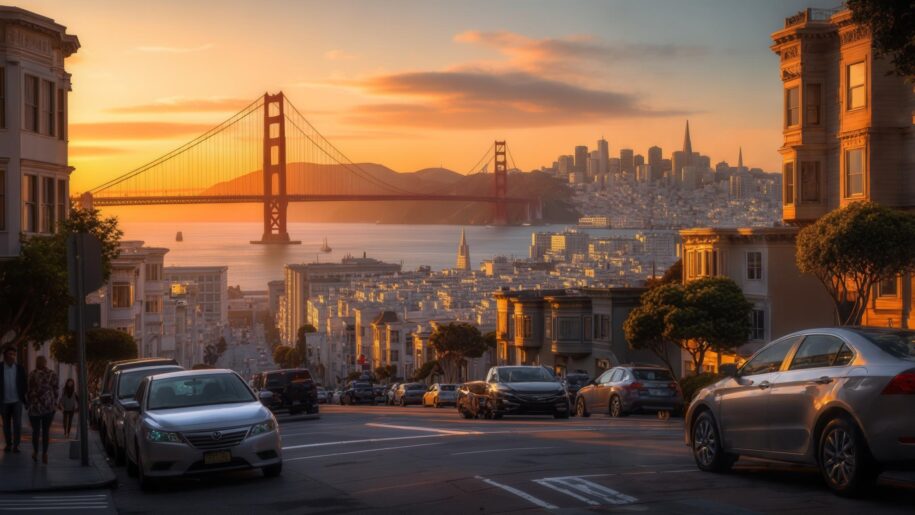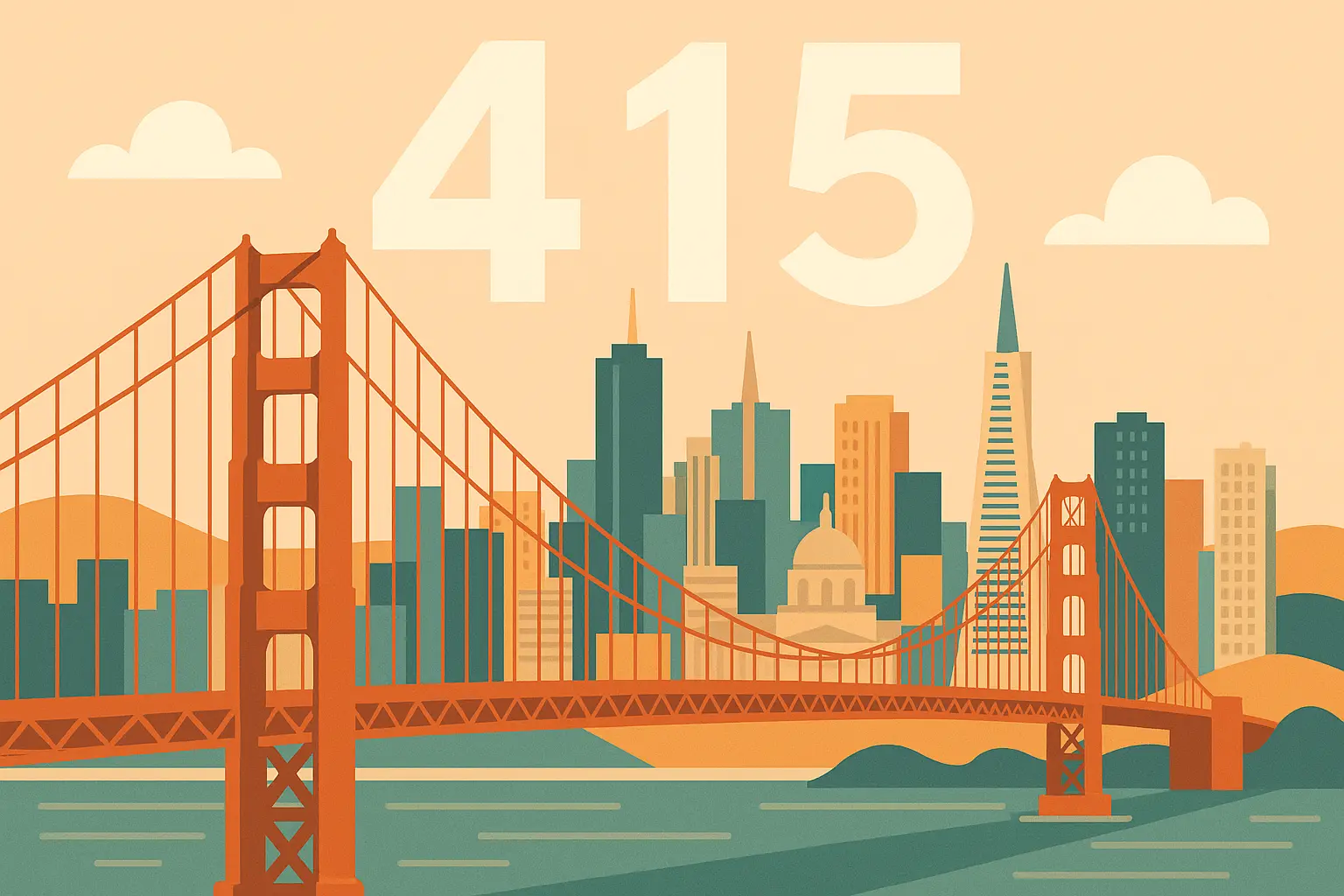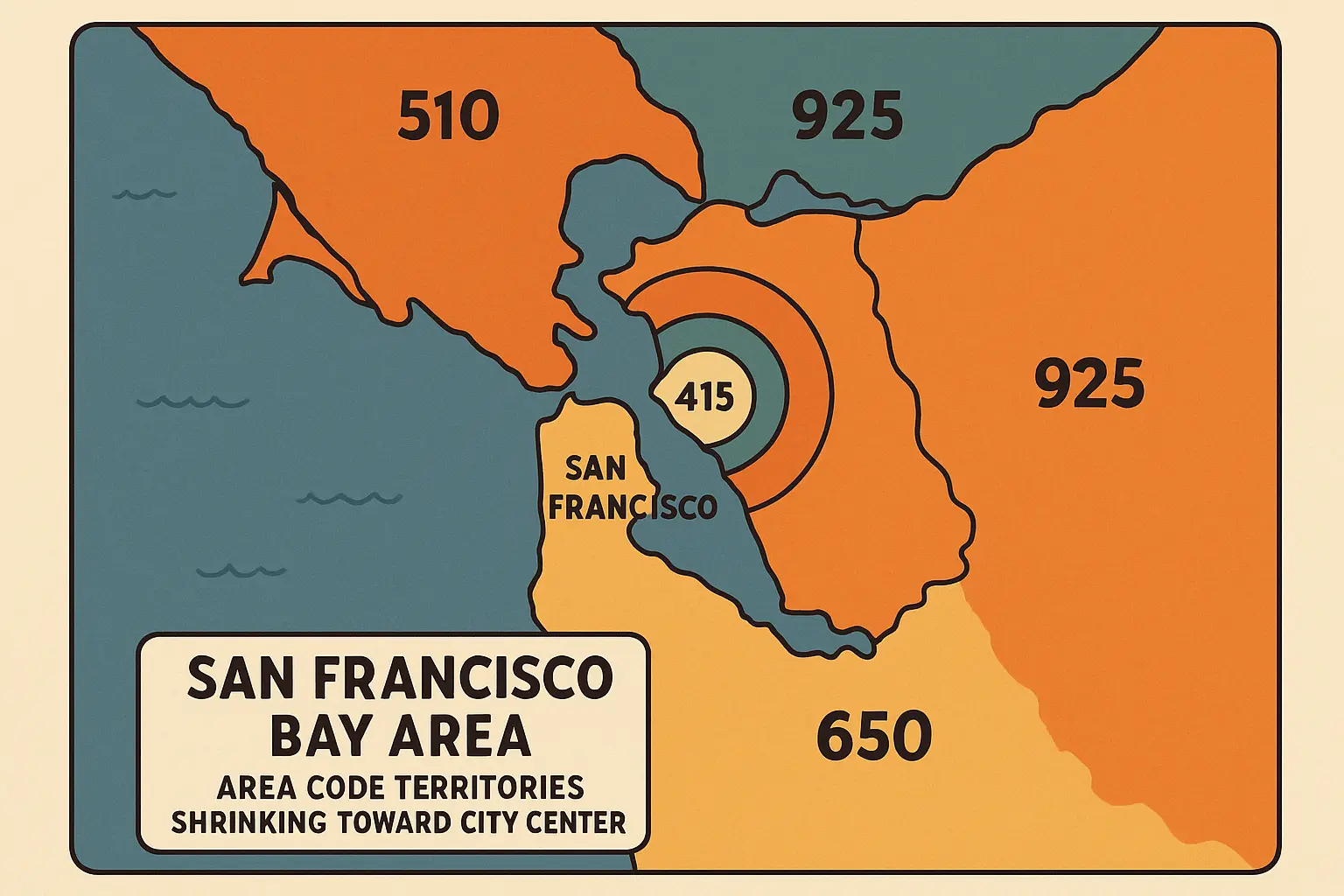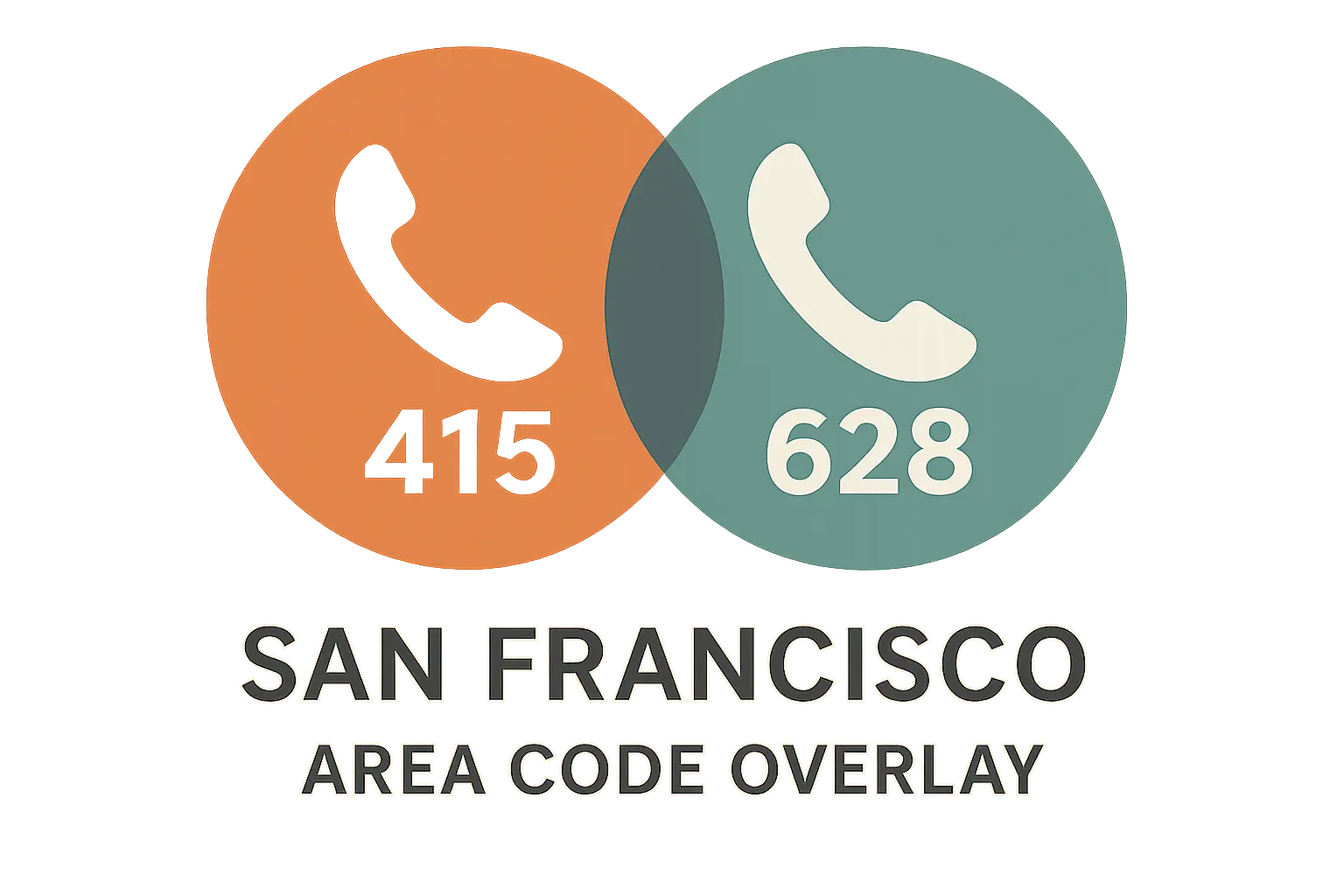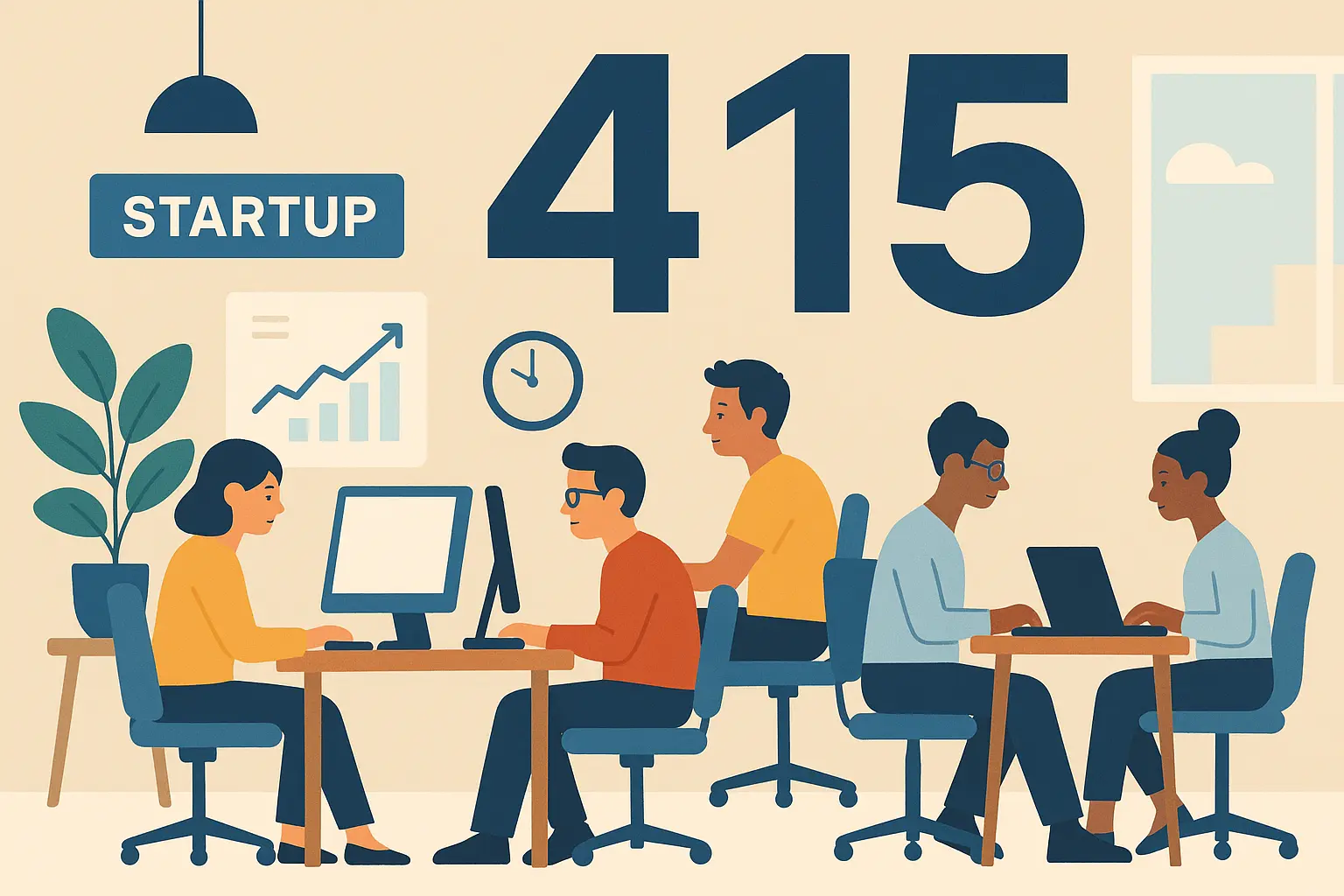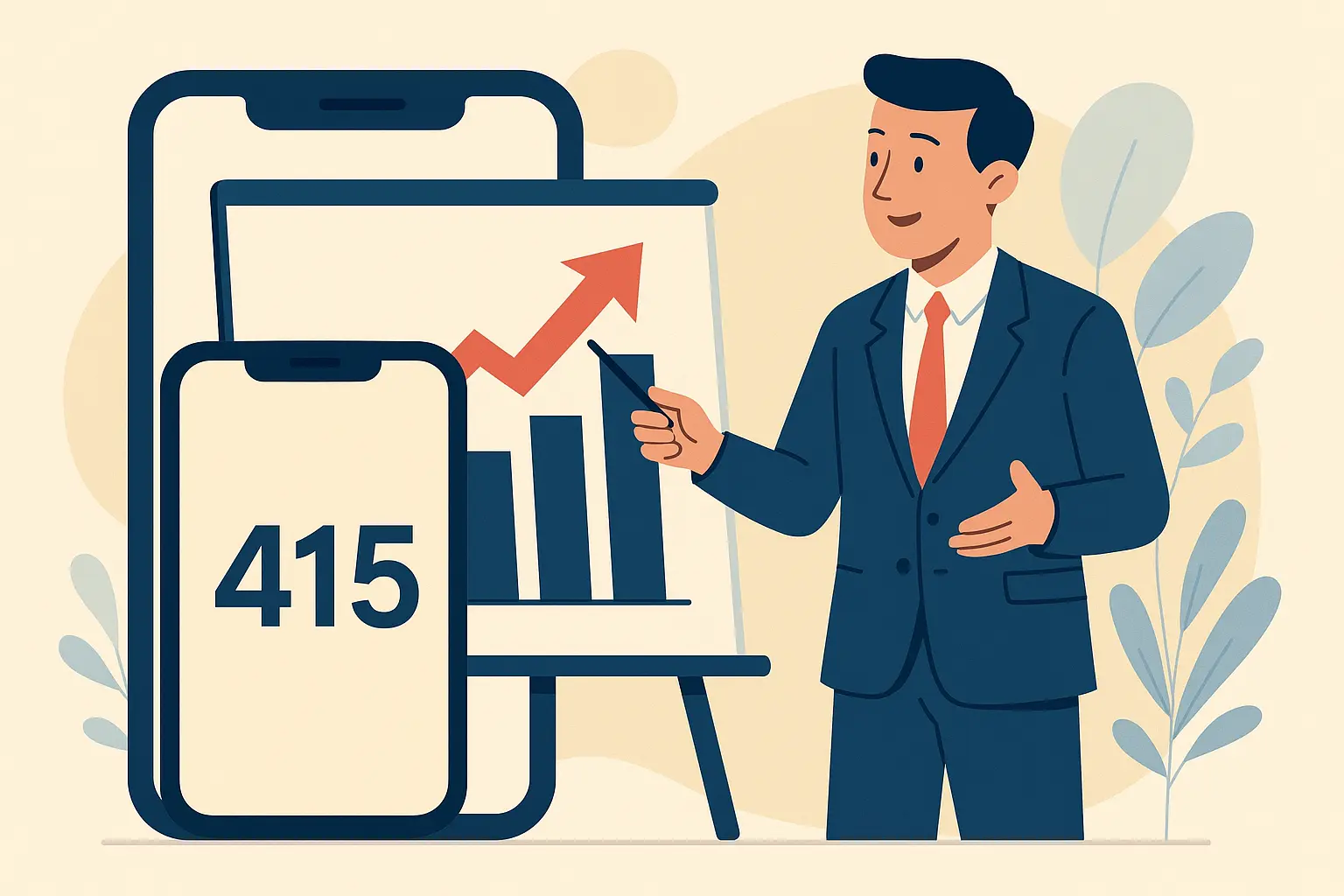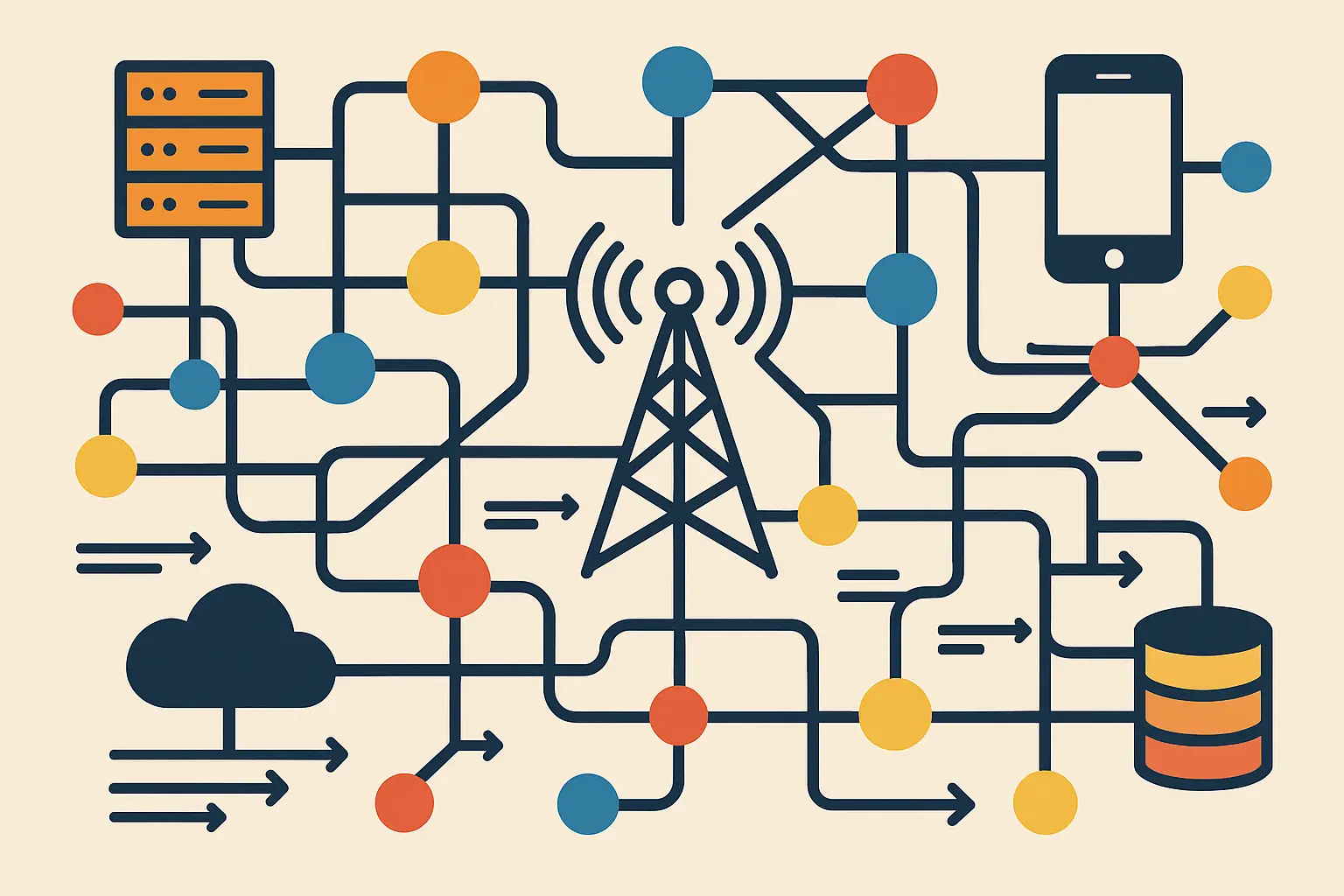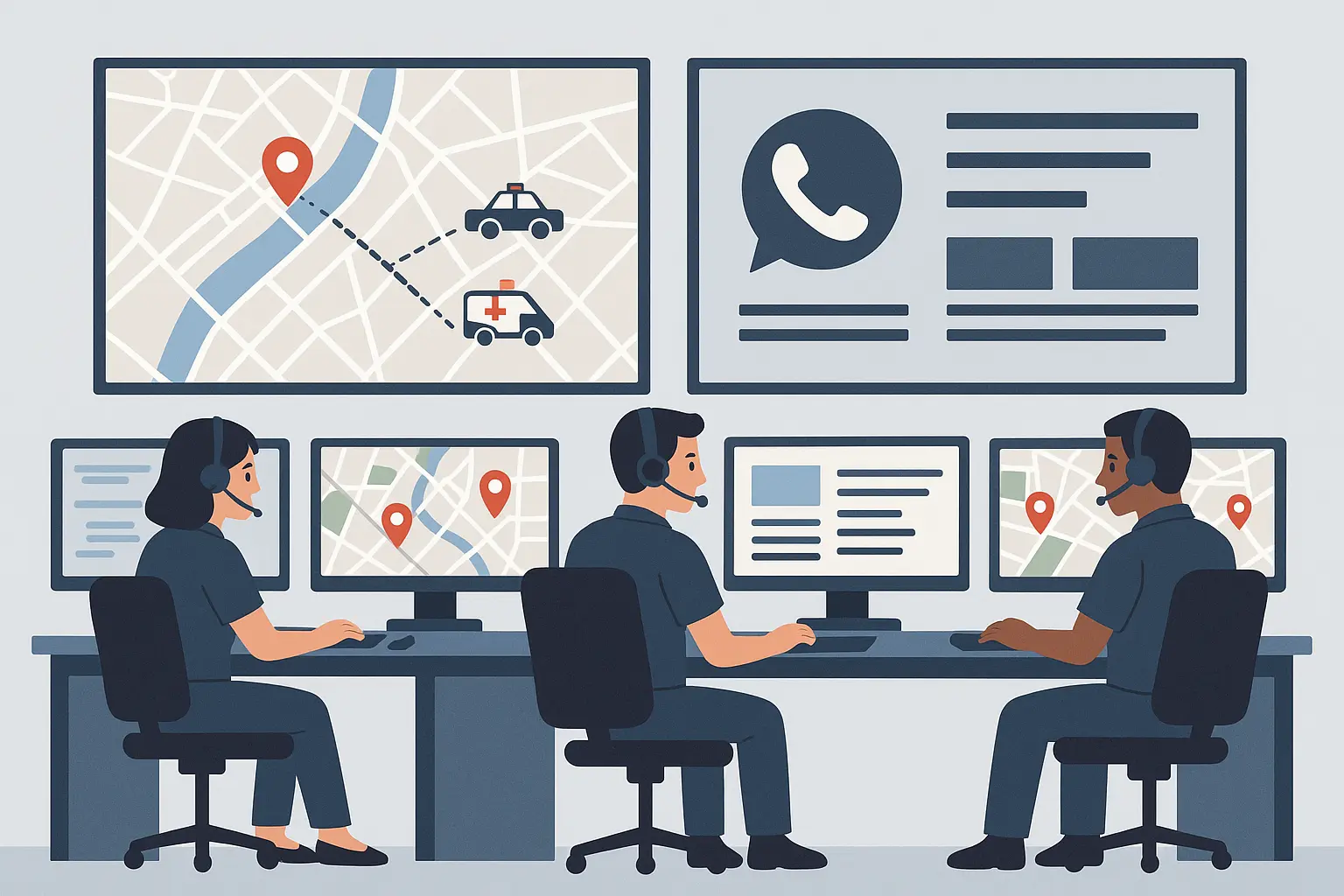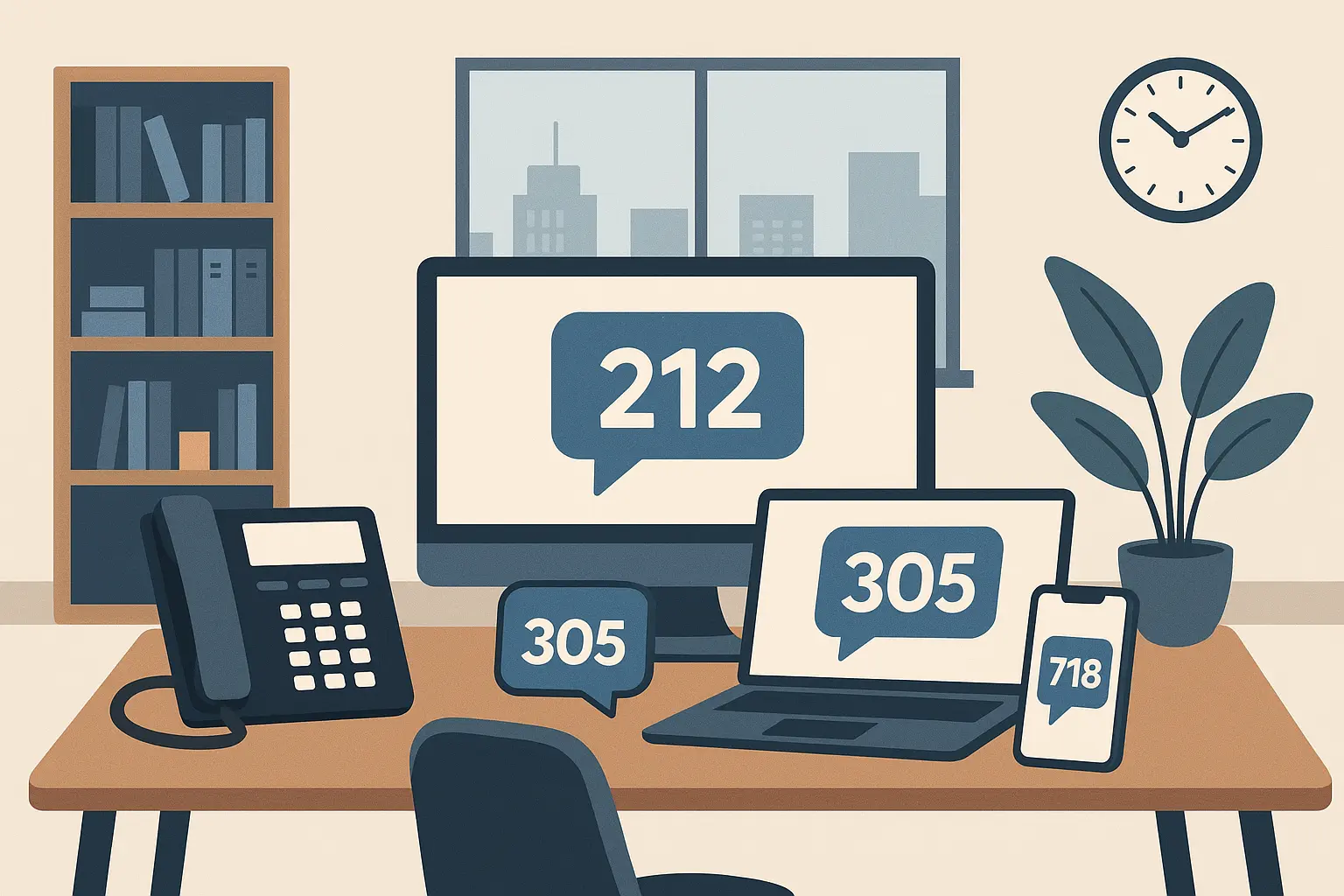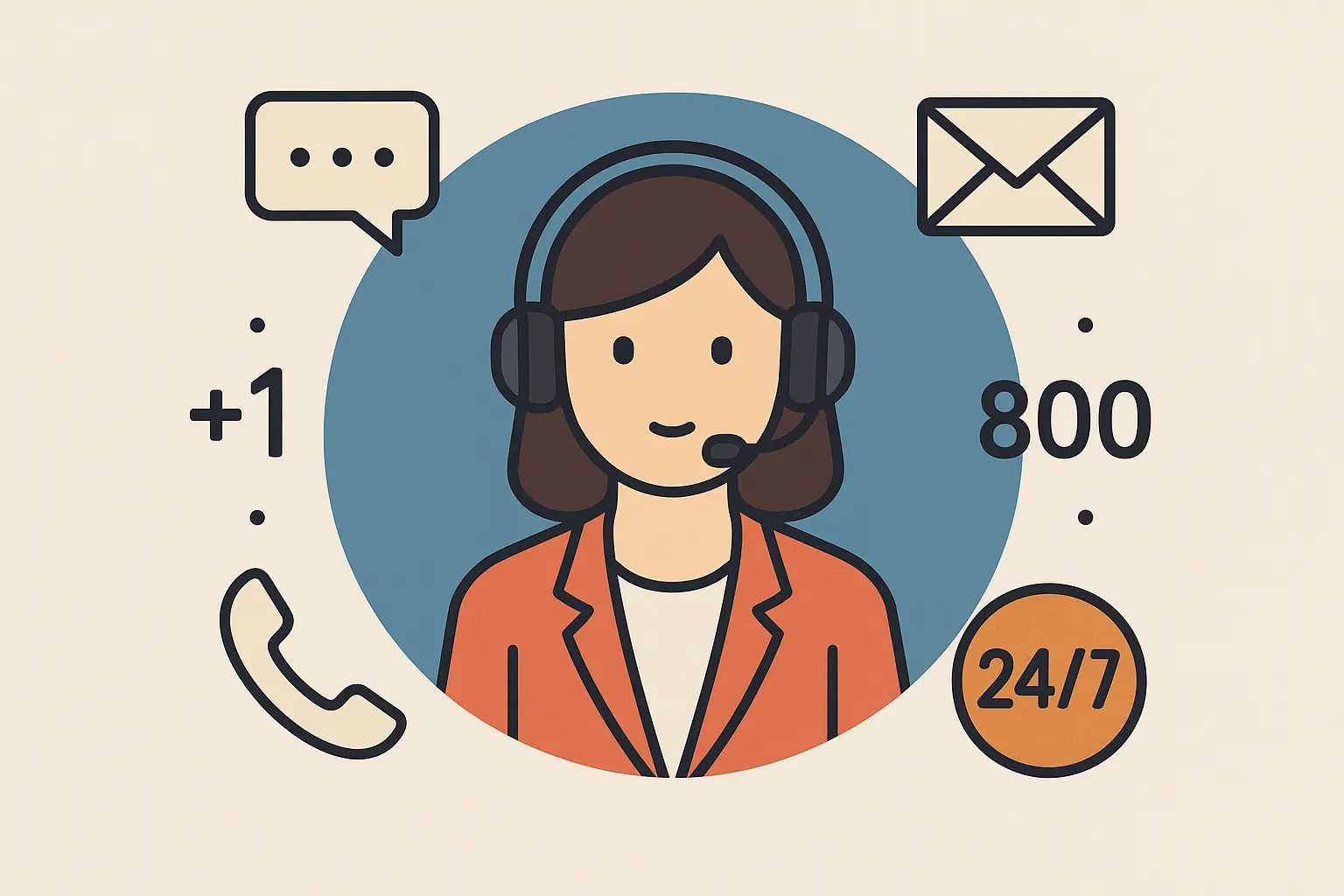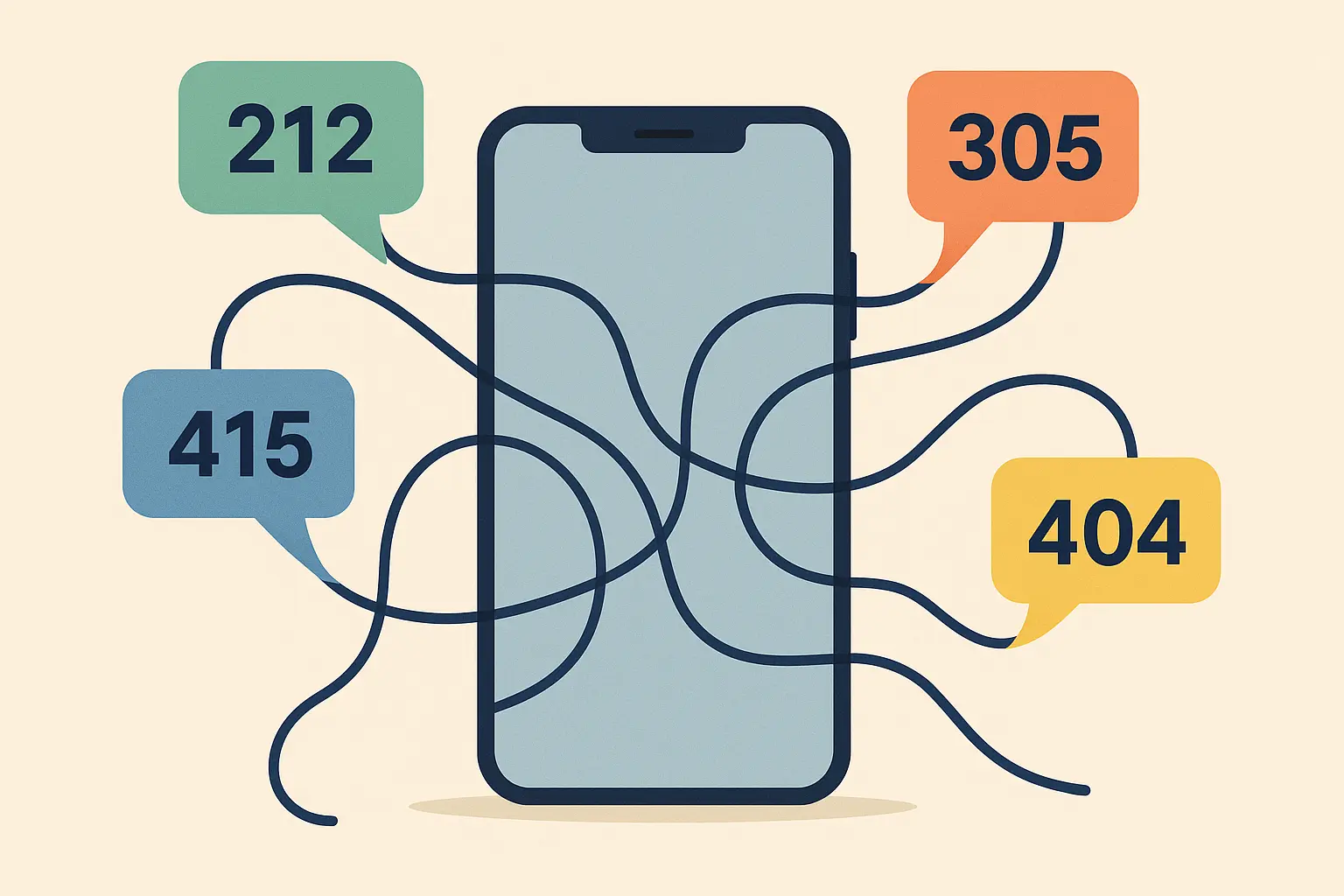If you’ve ever wondered why getting a 415 phone number feels like winning the lottery in San Francisco, you’re not alone. This little three-digit code has become way more than just a way to make phone calls – it’s basically a status symbol that screams “I made it in SF.” With approximately 1.2 million people and a median household income of $137,282, the 415 area code covers one of the most economically concentrated regions in the United States.
Table of Contents
Table of Contents
-
Geographic Evolution: How 415 Became San Francisco’s Golden Ticket
-
The 628 Overlay Reality Check: What Really Happened
-
Why Your Area Code Actually Affects Your Business Success
-
The Hidden Tech Infrastructure Running Your Phone Calls
-
Smart Communication Strategies for the 415/628 World
-
Final Thoughts
TL;DR
-
The 415 area code has shrunk from covering most of Northern California to just San Francisco, making it a concentrated symbol of prestige and economic power
-
The 628 area code wasn’t just about running out of numbers – it was a strategic business decision to protect San Francisco’s brand identity
-
Tech startups actively seek 415 area numbers because investors subconsciously associate them with Silicon Valley credibility
-
Complex telecommunications infrastructure manages millions of calls daily across the overlay system, including sophisticated emergency services coordination
-
Businesses can optimize their communication strategies by understanding how customers perceive different area codes and implementing smart message routing systems
Geographic Evolution: How 415 Became San Francisco’s Golden Ticket
You know how some people collect vintage sneakers or rare baseball cards? Well, in San Francisco, people collect 415 phone numbers. And honestly, it makes perfect sense once you understand what happened.
Back in the day, your 415 number could reach pretty much anywhere in Northern California. Imagine calling from San Francisco to Sacramento with the same area code – that’s how big this thing used to be. But then California went absolutely crazy with growth, especially during all those tech booms, and suddenly everyone needed a phone number.
Understanding this evolution helps explain where is area code 415 and why certain area codes carry more weight than others in business and social contexts. The systematic reduction of the 415 area code location wasn’t arbitrary – it directly correlates with California’s population explosions and economic boom periods.
The Territory Shrinkage That Made 415 Valuable
Here’s where it gets interesting: every time they had to split off a new area code, it wasn’t random. It was like watching a really expensive game of musical chairs. The East Bay got rich enough to deserve its own code (510 in 1991). The Peninsula started booming with all those dot-com companies, so they got 650 in 1997. Each split was basically saying “congratulations, you’re now too important to share an area code.”
What’s wild is that every time 415 lost territory, what was left became more valuable. It’s like if you started with a huge pizza and people kept taking slices, but somehow each remaining slice became worth more money. By the time all the splitting was done, 415 only covered San Francisco proper – which happened to be some of the most expensive real estate on the planet.
According to ZipAtlas demographic data, the 415 area code now serves a total population of 1,180,600 people concentrated in one of the smallest geographic areas of any major metropolitan area code, creating an unprecedented population density that drives telecommunications demand.
|
Year |
Split Event |
Area Removed |
Economic Context |
|---|---|---|---|
|
1959 |
707 & 408 creation |
North Bay & South Bay |
Post-WWII suburban expansion |
|
1991 |
510 split |
East Bay (Alameda County) |
Early tech industry growth |
|
1997 |
650 split |
Peninsula |
Dot-com boom beginning |
|
1998 |
925 & 831 splits |
Contra Costa & Santa Cruz |
Internet infrastructure expansion |
|
2015 |
628 overlay |
No geographic split |
Smartphone era demand |
The Economics Behind Every Split
Area code splits aren’t about running out of numbers – they’re economic indicators that reveal which regions are experiencing rapid business growth and population increases. The timing of 415’s splits correlates directly with major economic events, making the area code’s evolution a unique lens for understanding where the money’s flowing.
Every time 415 lost territory, it was because that region had become economically significant enough to demand its own identity. The 1991 split happened during a recession, but the East Bay was still growing. The 1997 Peninsula split coincided with the early internet boom when companies like Yahoo and Google were establishing their presence.
What’s fascinating is how each split concentrated the 415 area code location into increasingly expensive real estate. By the time the dust settled, 415 covered only San Francisco proper – which happened to be some of the most valuable urban real estate in the country.
Why 415 Numbers Became Digital Gold
Here’s something that’ll blow your mind: as the 415 area territory got smaller, the property values in that area went through the roof. This wasn’t just coincidence – it was pure concentration of wealth and power.
Tech companies figured this out way before everyone else. Having a 415 number became like wearing a designer label that says “we’re not some suburban startup working out of a strip mall.” It’s shorthand for “we’re in the big leagues, baby.”
Understanding proper phone number formatting becomes crucial for businesses managing multiple area codes, especially when dealing with international clients who need to recognize US phone number format with country code for effective communication.
The cultural significance of 415 extends beyond business into community identity. “415 Day is a borderline political rally” according to Mission Local, where San Francisco natives celebrate their area code as a symbol of resistance against gentrification and cultural preservation. This demonstrates how deeply the 415 area has become embedded in local identity.
I’ve seen companies literally budget for 415 numbers the same way they budget for premium office space. Because in a weird way, your area code has become part of your address – and in San Francisco, address matters.
The 628 Overlay Reality Check: What Really Happened
So by 2015, San Francisco had a problem. Not a bad problem to have, but still a problem – they were running out of 415 numbers. Now, they could have done what they’d always done before: split the area geographically and give half the city a new area code.
But here’s where it gets smart: by 2015, 415 wasn’t just a phone number anymore. It was a brand. Imagine telling thousands of businesses “hey, remember that 415 number you’ve been using for 20 years? The one on all your business cards and websites? Yeah, you need to change it.” That would have been economic chaos.
The introduction of the 628 area code as an overlay rather than a geographic split represented a fundamental shift in telecommunications planning philosophy. This decision was driven by business continuity concerns and the recognition that 415 had become too valuable as a brand identifier to disrupt through traditional splitting methods.
The Business Protection Strategy Behind 628
So instead of splitting the city, they did something clever – they just layered a new area code (628) right on top of the existing area. Same city, two area codes. It’s like having two different zip codes for the same street.
When the California Public Utilities Commission faced the inevitable – 415 was running out of numbers – they chose overlay, and it wasn’t about convenience. By 2015, 415 had become integral to thousands of business identities. Forcing established companies to change their numbers would have created massive disruption in a region where business relationships and brand recognition drive billions in economic activity.
The overlay preserved business continuity while solving the number shortage. Smart policy, even if it confused some residents initially.
The transition wasn’t seamless for everyone. ABC7 News reported that “dozens of people called San Francisco’s 911 center because they’re having trouble dialing out” when the new 10-digit dialing system was implemented.
How San Francisco Adapted to 10-Digit Dialing
The transition wasn’t exactly smooth sailing. Suddenly, everyone had to dial 10 digits instead of 7, even for local calls. My friend’s grandmother called 911 three times in one week because she couldn’t figure out how to order pizza. (True story.)
Younger folks adapted pretty quickly – they were already storing full numbers in their phones anyway. But for older residents who’d been dialing 7 digits since the Nixon administration, it was like learning a new language.
Businesses had to scramble too. Restaurants had to retrain delivery drivers, offices had to update their phone systems, and everyone had to explain to confused customers why calling across the street suddenly required 10 digits.
A local San Francisco restaurant had to update their delivery system when area code 628 launched. Previously, their delivery drivers could dial 7-digit numbers for local confirmations. After the overlay, they implemented a new protocol requiring all staff to use 10-digit dialing, and created laminated reference cards showing the correct dialing format for different call types.
The Algorithm That Decides Your Area Code
Here’s something most people don’t know: when you request a new San Francisco phone number today, you’re not just getting whatever’s available. There’s actually a system – almost like an algorithm – that decides whether you get the coveted 415 or the newer 628.
When you request a new San Francisco phone number today, you’re not getting whatever’s available. Sophisticated algorithms determine whether you get 415 or 628 based on multiple factors: availability in your preferred exchange, your customer profile, and sometimes even your willingness to pay premium rates.
Phone companies know that 415 numbers are more desirable (and people will pay more for them), so they’ve gotten strategic about who gets what. Business customers often get priority for 415 numbers, while regular folks are more likely to get 628. It’s supply and demand, but for phone numbers.
It’s like having a VIP line at a club, except the club is the entire telecommunications system and the VIP section is three digits long.
Why Your Area Code Actually Affects Your Business Success
Okay, this might sound crazy, but your area code can literally affect how successful your business is. I know, I know – it’s just three numbers, right? But in the world of San Francisco tech and business, those three numbers carry a lot of weight.
In the digital economy, area codes have evolved beyond simple geographic identifiers to become brand assets that influence customer perception, investor interest, and business credibility. The area code 415 carries particular weight in the technology sector, where San Francisco location signals innovation and market access.
The economic concentration is remarkable: ZipAtlas data shows that the median family income in Area Code 415 is $174,799, with families comprising 2 earners having the highest median family income of $211,948, demonstrating the premium economic status associated with the area code 415.
The Startup Credibility Factor
I’ve watched startups specifically hunt for 415 numbers like they’re searching for the perfect domain name. And it’s not just vanity – there’s real psychology happening here. When an investor sees a 415 number on a pitch deck, their brain immediately goes “San Francisco tech company” before they even read what the company does.
Here’s a story that perfectly illustrates this: A friend of mine was running a tech startup and using a 650 number (Peninsula area code). He noticed that when he’d cold-call potential investors or partners, he’d often get asked “So where are you actually based?” – even though 650 is literally right next to San Francisco.
After he switched to a 415 number, those questions stopped. Same company, same location, same pitch – but suddenly people assumed he was “in the ecosystem.” It’s not fair, but it’s reality.
Technology startups specifically target 415 area numbers as part of their Silicon Valley credibility strategy, recognizing that area codes can influence investor perceptions and customer trust. Research indicates that 415 numbers can create subconscious positive associations with innovation and tech industry legitimacy, making them valuable marketing assets for emerging companies.
The Investor Psychology Behind Area Codes
VCs process hundreds of pitches every month, and they make snap judgments based on tiny details. A 415 number suggests you’re embedded in the San Francisco tech scene – that you have access to the talent, advisors, and market intelligence that comes from being in the heart of it all.
A 415 number suggests you’re embedded in the San Francisco tech ecosystem – that you have access to talent, advisors, and market intelligence that comes from being physically present in the innovation capital. It’s not fair, but it’s reality.
TechCrunch Disrupt 2023 featured a panel where three VCs admitted they subconsciously give extra attention to pitches from companies with area code 415 numbers. One partner explained: “When I see 415, I immediately think ‘they’re in the ecosystem.’ It doesn’t guarantee funding, but it does guarantee I’ll take the call.”
The Marketing Asset Value of Area Codes
Smart companies now treat 415 numbers like premium domain names – they’re willing to pay extra because they know it’s an investment that pays for itself. I’ve seen businesses pay significant premiums to acquire area code 415 numbers from other companies, treating them as marketing assets rather than just utility expenses.
The math is pretty straightforward: if a 415 number increases customer trust by even 5%, or makes one investor take your call who otherwise wouldn’t have, it’s probably paid for itself
Think about it – your area code appears on every business card, email signature, website, and investor communication. In a city where first impressions can make or break deals worth millions, those three digits matter more than most people realize.
415 Number Acquisition Checklist:
-
Research available 415 exchanges in your target neighborhood
-
Compare premium pricing across multiple carriers
-
Evaluate vanity number options (memorable digit patterns)
-
Consider number portability requirements if switching carriers
-
Budget for potential premium costs (typically 20-50% above standard rates)
-
Document business case for 415 number investment
-
Plan marketing materials that prominently feature the 415 number
The Hidden Tech Infrastructure Running Your Phone Calls
You probably don’t think much about what happens when you make a phone call, but the system running behind San Francisco’s 415/628 overlay is absolutely mind-blowing. We’re talking about some seriously sophisticated engineering that makes the internet look simple.
The technical systems supporting the 415/628 overlay represent some of the most sophisticated telecommunications engineering in the world. These invisible networks manage number portability, optimize call routing, and coordinate emergency services across millions of phone numbers.
Every single phone call involves split-second decisions by massive computer systems that figure out exactly how to get your voice from point A to point B. And when you throw in the complexity of two area codes covering the same geographic area, plus people switching carriers but keeping their numbers, it becomes this incredible technological juggling act.
Understanding this infrastructure reveals the complexity behind seemingly simple phone calls and text messages in the 415 area. The engineering challenges involve massive data management and split-second decision making that most users never consider but rely on for every communication they make.
The Number Portability Engineering Marvel
Here’s something that’ll make your head spin: every time someone switches phone carriers but keeps their number, databases all across the country have to update in real-time. We’re talking about systems that process millions of these updates daily, making sure that when someone calls your 415 number, it actually reaches you no matter which company is providing your service.
Every time you switch carriers but keep your phone number, you’re benefiting from incredibly sophisticated database systems. These networks must update routing information across multiple carriers in real-time, ensuring that calls to your 415 area number reach you regardless of which company currently provides your service.
The complexity multiplies with overlay area codes. The system must track which carrier serves each number and maintain accurate geographic and routing information for both 415 and 628 numbers in the same geographic area.
The scale is absolutely bonkers. These systems are tracking and routing information for hundreds of millions of phone numbers, updating routing tables across thousands of The scale is staggering: demographic data shows that 67.7% of people are in the labor force in Area Code 415, representing 693,267 active workers who rely on these telecommunications systems for daily business communications.
Real-Time Database Coordination
Behind every phone call is a split-second database query that determines the optimal routing path. These systems process millions of lookups daily, coordinating between carriers to ensure your call reaches its destination efficiently.
The databases must stay synchronized across the entire telecommunications network. When someone ports their 415 area number to a new carrier, that information propagates through multiple systems within minutes, updating routing tables nationwide.
And here’s the kicker – it all has to work perfectly, because when someone dials 911, there’s no room for error.
|
Infrastructure Component |
Function |
Scale |
Response Time |
|---|---|---|---|
|
Number Portability Database |
Tracks carrier assignments |
500M+ numbers |
<100ms |
|
Call Routing Systems |
Determines optimal path |
10B+ calls/day |
<50ms |
|
Emergency Location Database |
Maps numbers to addresses |
300M+ locations |
<10ms |
|
Carrier Interconnect Networks |
Facilitates cross-carrier calls |
1000+ carriers |
<200ms |
Emergency Services in the Overlay Era
Speaking of 911, emergency services coordination in the overlay era is like air traffic control on steroids. When someone calls 911 from a San Francisco number – whether it’s 415 or 628 – the system has to instantly figure out exactly where they are and route the call to the right emergency services.
Emergency services coordination becomes exponentially more complex with overlay area codes. When someone calls 911 from a san francisco area code number, whether 415 or 628, the system must instantly determine their precise location and route the call to the appropriate emergency services.
This isn’t just about area codes anymore. The system needs to know your precise location, which police jurisdiction you’re in, which fire department covers your area, and which hospital is closest. All of this happens in seconds, while someone might be having the worst day of their life.
This requires maintaining detailed geographic databases that map every phone number to specific addresses and emergency service jurisdictions. The accuracy requirements are strict – lives depend on getting emergency responders to the right location quickly.
Multi-Jurisdiction Emergency Coordination
San Francisco’s emergency services must coordinate with multiple agencies across the overlay area. A 911 call might need police, fire, or medical response, and the system must instantly determine which jurisdiction and which specific units to dispatch.
The overlay system adds complexity because emergency services can’t rely on area code alone to determine location. They need precise address matching and real-time coordination between different emergency response agencies.
During emergencies like power outages or earthquakes, these systems get absolutely hammered with calls, but they have to keep working flawlessly. It’s honestly amazing that it works as well as it does.
During the 2019 power shutoffs, San Francisco’s emergency dispatch system processed over 40% more calls than normal. The 415/628 overlay system automatically routed calls based on precise GPS coordinates rather than area codes, ensuring that emergency responders reached the correct neighborhoods even when residents were confused about which area code to use.
Smart Communication Strategies for the 415/628 World
If you’re running a business in San Francisco, you need to think strategically about how you handle the whole 415/628 situation. You can’t just treat them as interchangeable – your customers definitely don’t see them that way.
Businesses operating in the 415/628 overlay area can optimize their communication strategies by understanding customer perceptions, implementing smart routing systems, and maintaining brand consistency across multiple area codes. These strategies help companies leverage the unique characteristics of the overlay system while avoiding common pitfalls that can confuse customers or dilute brand identity when managing area codes for san francisco.
Managing Multi-Area Code Business Communications
The smart move is to develop clear rules about which area code to use for what. Maybe your main customer service line uses 415 for brand recognition, while your internal operations use 628 for cost efficiency. The key is being consistent and making sure your team understands the strategy.
Running a business with both 415 and 628 numbers requires strategic thinking about customer communication flows. You can’t treat them as interchangeable – customers have different expectations and perceptions for each area code.
Here’s what I’ve learned from watching businesses navigate this: you need protocols. Which area code do customers see on your website? Which one goes on your business cards? What happens when someone calls the “other” number?
I recommend developing clear protocols for which area code for san francisco to use in different business contexts. Customer service might use 415 for brand recognition, while operational teams might use 628 for cost efficiency. The key is consistency and clear internal guidelines.
For businesses managing multiple phone numbers, implementing text message forwarding to email ensures that important communications don’t get lost across different area codes 415 and 628 systems.
Multi-Area Code Management Protocol:
-
Assign specific area codes to different business functions
-
Train staff on customer expectations for each area code
-
Implement call forwarding between 415 and 628 numbers
-
Create customer education materials explaining your area code strategy
-
Monitor customer feedback across both area codes
-
Establish emergency backup protocols for system failures
-
Review and update area code assignments quarterly
Brand Consistency Across Area Codes
The businesses that do this well treat it like any other branding decision. They don’t leave it to chance – they make deliberate choices about how to present themselves across both area codes.
Your brand identity shouldn’t change based on which area code customers use to reach you. This means developing consistent messaging templates, training customer service teams on area code implications, and creating customer education materials that explain your multi-area code presence.
Monitor brand perception metrics across both area codes. Customers might have different expectations when calling a 415 versus 628 number, and your team should be prepared to meet those expectations consistently.
Modern businesses benefit from forwarding text messages to Slack channels to maintain team coordination when managing communications across multiple San Francisco area codes.
Advanced Message Management Solutions
And here’s something most people don’t think about: you need systems in place to make sure important messages don’t get lost in the shuffle. When you’re managing multiple phone numbers across different area codes, things can slip through the cracks if you’re not careful.
Managing business communications across multiple area codes creates unique challenges that traditional phone systems weren’t designed to handle. You need solutions that can route messages intelligently, maintain communication continuity, and integrate with your existing business systems.
This is where Auto Forward SMS becomes invaluable for San Francisco businesses. When you’re managing both 415 and 628 numbers for different business functions, you need a system that ensures important messages reach the right team members regardless of which area code customers use.
Getting started with automated message forwarding is straightforward when you understand the initial setup process for Auto Forward SMS and how it handles multiple area code configurations.
Auto Forward SMS solves these challenges by centralizing multi-area code SMS management, creating area code-specific routing rules, and maintaining communication continuity when team members are unavailable. Whether a customer texts your 415 number or your 628 number, the system ensures the right people receive and can respond to those messages promptly.
For businesses in San Francisco’s competitive market, missing customer communications due to area code confusion can mean lost opportunities. Auto Forward SMS helps maintain the professional responsiveness that San Francisco businesses need to succeed.
Advanced users can integrate API endpoint forwarding to create sophisticated routing systems that automatically categorize and distribute messages based on the originating area code and message content.
SMS Management Best Practices Checklist:
-
Set up automated routing rules for different area codes
-
Create backup forwarding chains for after-hours messages
-
Implement keyword-based routing for different service types
-
Monitor response times across both 415 and 628 numbers
-
Train team members on area code-specific customer expectations
-
Establish escalation protocols for urgent messages
-
Review and optimize routing rules monthly
Final Thoughts
The 415 area code is way more than just three digits you dial before a phone number. It’s become this fascinating symbol of San Francisco’s transformation from a regular city into the tech capital of the world.
The 415 area code represents far more than a simple geographic identifier – it’s become a symbol of San Francisco’s economic evolution and technological leadership. Understanding the hidden infrastructure, business implications, and strategic opportunities within the 415/628 overlay system gives you insights that most people never consider.
Understanding all this hidden complexity – the infrastructure, the psychology, the business implications – gives you insights that most people never think about. Whether you’re trying to build a startup, manage business communications, or just understand why some phone numbers seem more “prestigious” than others, now you know the real story.
Whether you’re running a startup seeking credibility, managing business communications across multiple area codes, or simply curious about the systems that power your daily phone calls, these insights reveal the sophisticated world operating behind every number you dial. The next time you see a 415 area code, you’ll know you’re looking at a piece of San Francisco’s digital identity that carries decades of economic history and technological innovation.
The next time you see a 415 number, you’ll know you’re looking at a little piece of San Francisco history that represents decades of economic growth, technological innovation, and the weird ways that simple things like area codes can become status symbols in our modern world.
